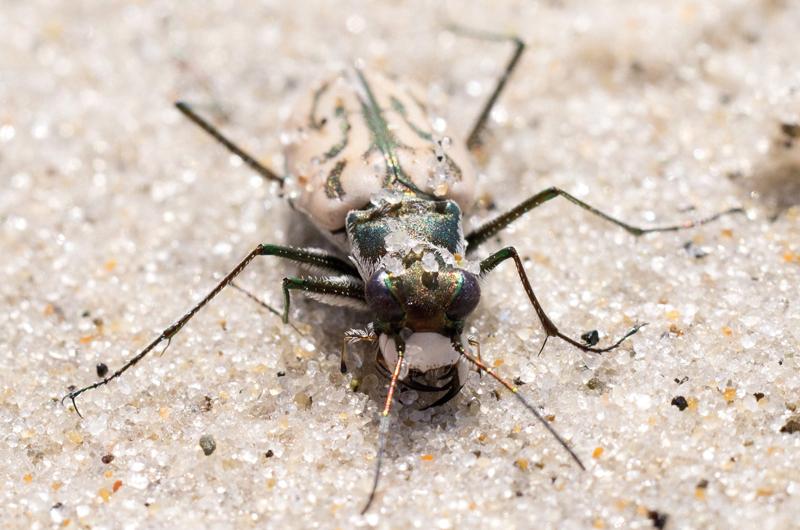An ecological success story has been taking place largely out of sight – underfoot and under the sand on the south shore, where the northeastern beach tiger beetle has been making a comeback. The larvae of the striped, sand-colored beetles with big jaws (Cicindela dorsalis dorsalis) live under the sand farther back from the shoreline in the winter and then feed closer to the water in the summer. The adults, in turn, mate and lay eggs in the second summer of their life. The beetles feed on small invertebrates and dead fish and are themselves an important food source for migratory birds. As such they have long been considered a symbol of a healthy coastal ecosystem. By the late twentieth century, however, the once-abundant species had all but disappeared from the Atlantic coast, largely depleted by development and over-sand vehicle traffic. It was believed they were entirely extirpated from New England.
But in 1989 Tim Simmons, then the executive director of the Sheriff’s Meadow Foundation, found a population of the beetles on a beach near Squibnocket. From then on he and other ecologists have carefully monitored the Vineyard population, walking the beaches in the late spring and summer months to look for their vertical burrows (easy to identify because other beetles burrow at an angle). Last July, Simmons, now with the Massachusetts Natural Heritage and Endangered Species Program, counted nearly 1,500 beetles, probably about one-third of the actual population.

What’s more, their territory seems to be expanding along barrier beaches from Lucy Vincent all the way to Edgartown Great Pond. Once every three years, Simmons has walked a stretch of beach there in search of additional beetles, always coming up empty. “Last year I just kayaked over...and there they were,” he said. “I had two that day.” It remains to be seen if this is a breeding population, but it could signal a territorial expansion. “They’re trying to recover old ground, and maybe they will,” he said.
Some descendants of local beetles are thriving to the west, at Monomoy National Wildlife Refuge. In the early 2000s some of the Vineyard beetles were transplanted to the barrier islands off the Cape, where traffic is banned. Now, according to Simmons, “there are so many that we can’t count them anymore.”
In addition to the lack of over-sand traffic, the beach is accreting at Monomoy, creating more of the broad, untouched coastline that the species favors. The population has gone beyond experimental to become a part of the food chain – the way it should be, Simmons said. Literature from the early 1900s describes massive swarms of beach tiger beetles providing fuel for migratory birds as they headed north.
That is starting to happen at Monomoy, he said. “You have dragonflies and birds that are following these swarms and just feeding on them,” he said. “And with the population at that level, they can afford it.
“I think they’re doing well,” Simmons concluded. “It would be nice to find some other sites so you didn’t have all your eggs in two baskets, so to speak, but we’re doing okay.”




